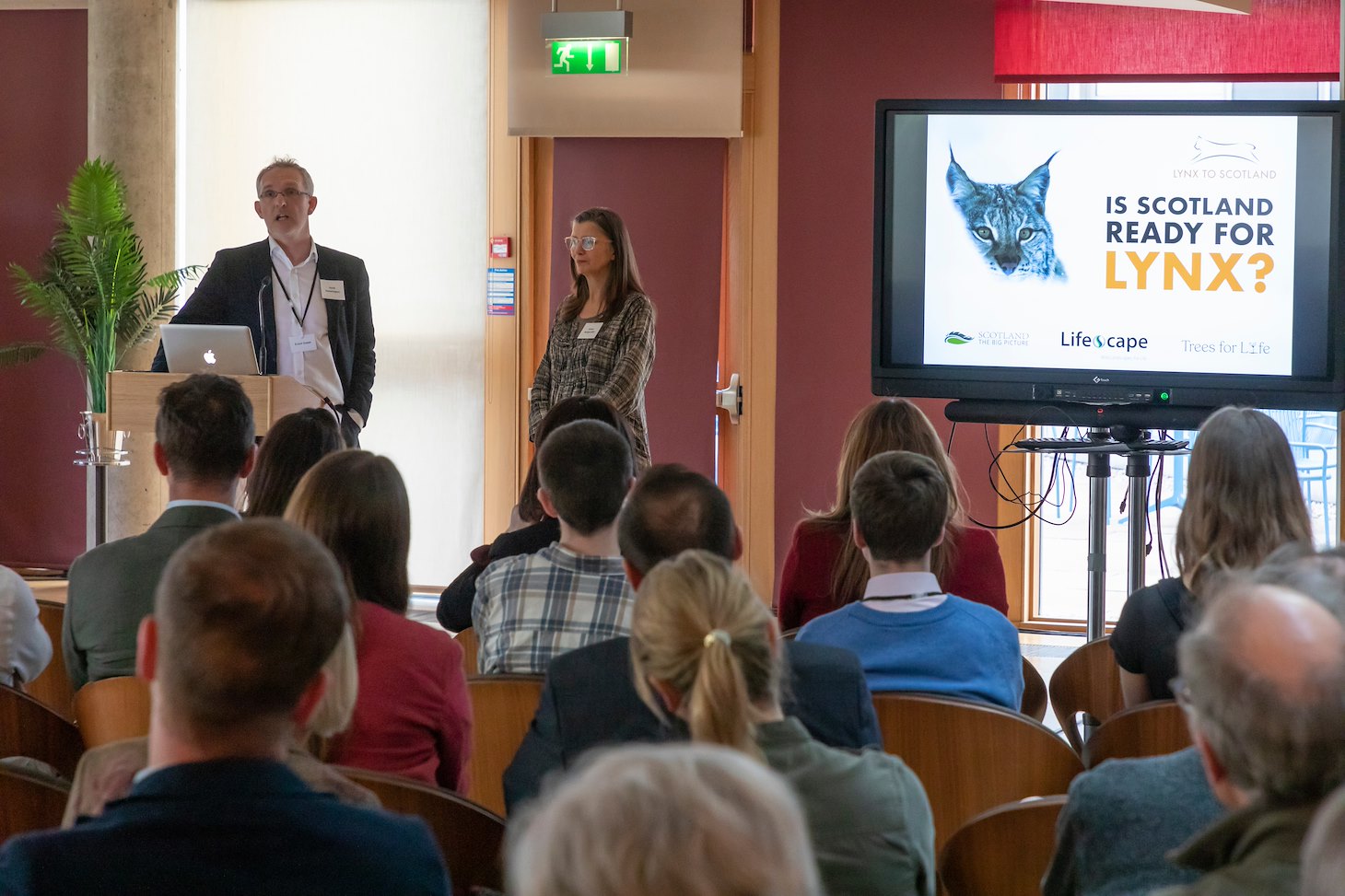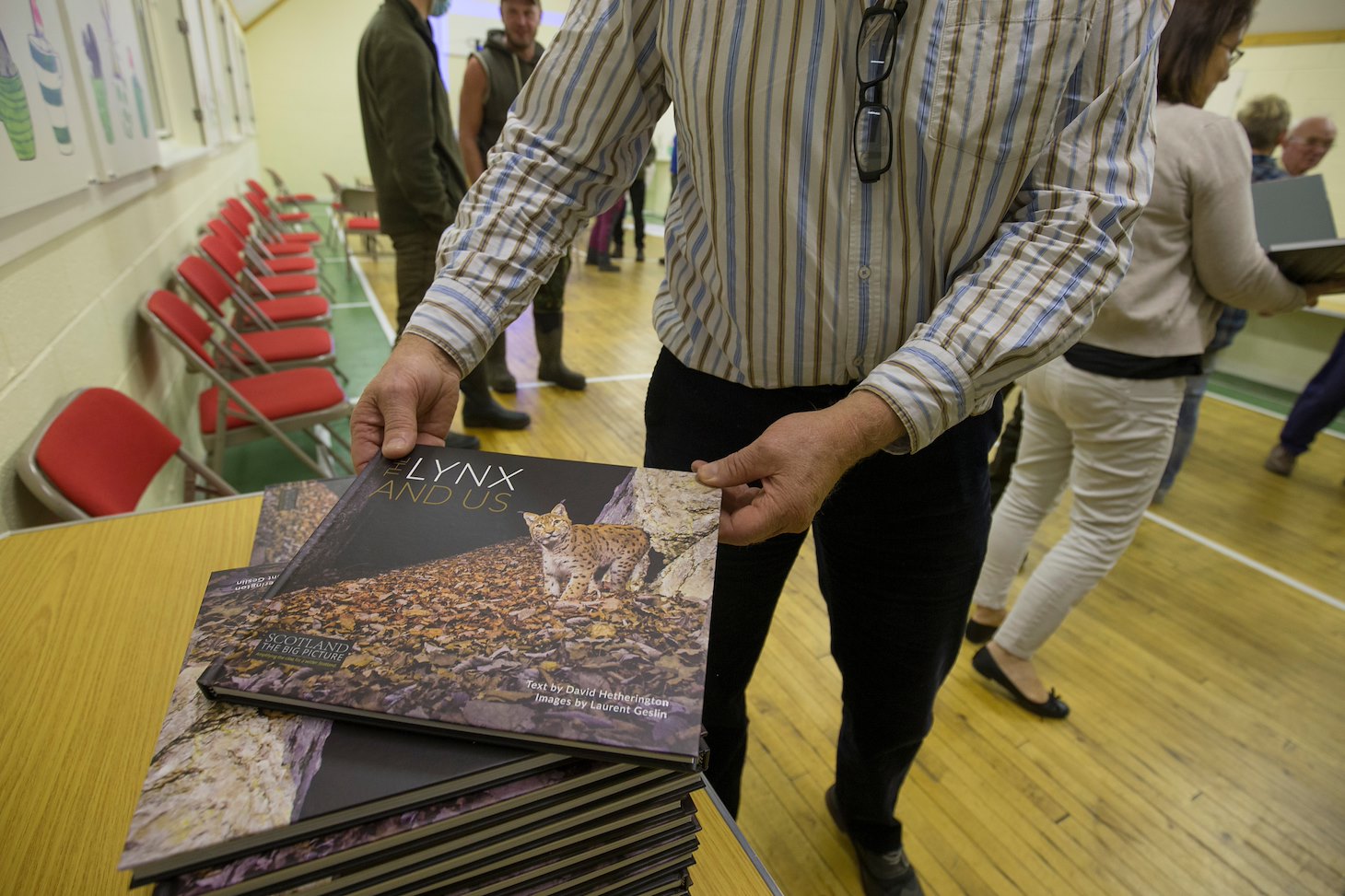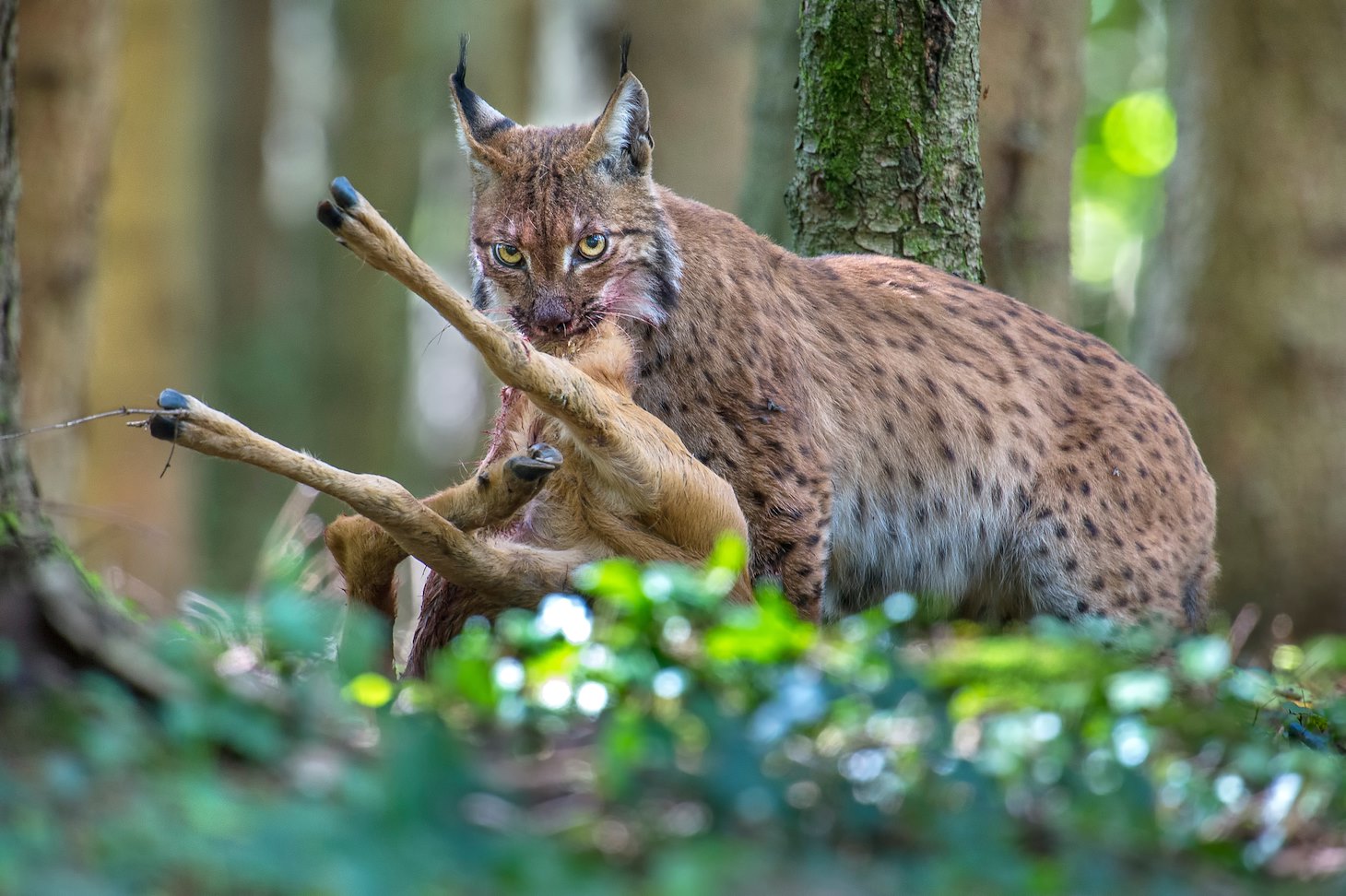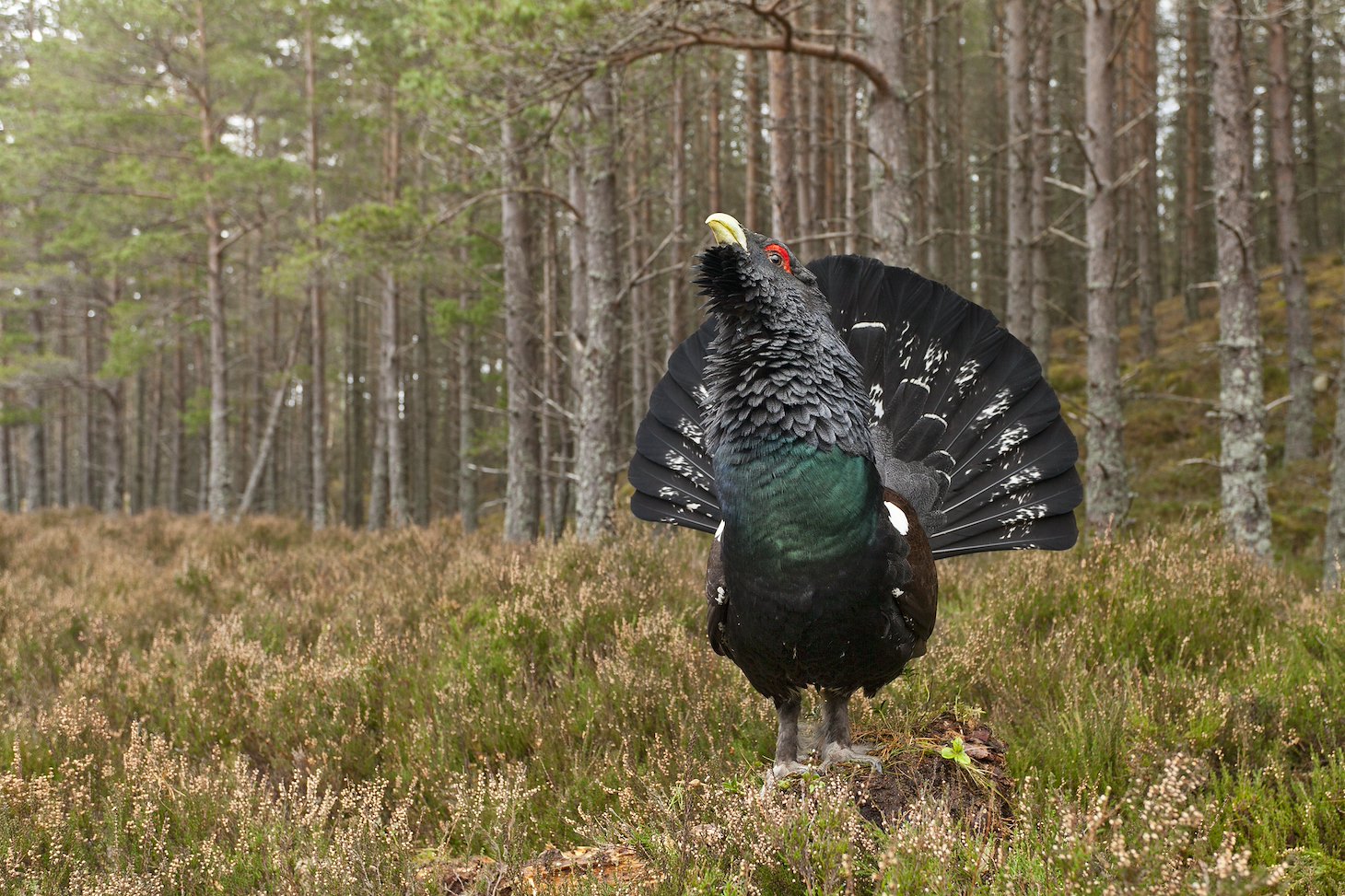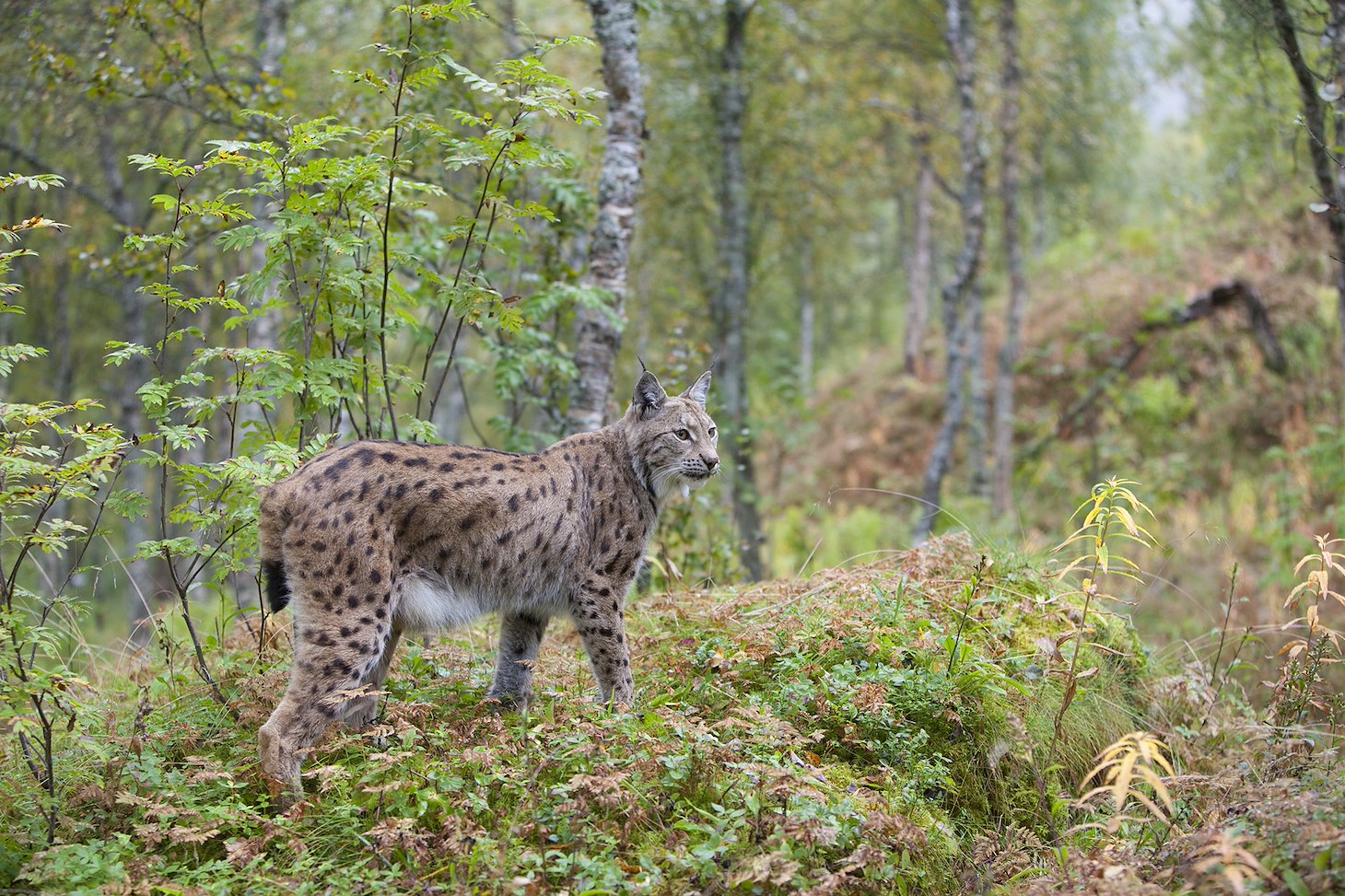BACKGROUND
Across mainland Europe, the Eurasian lynx is staging a comeback, benefiting from increasing public interest and reduced hunting pressure. Lynx continue to face localised threats from poaching, habitat fragmentation and the isolation of some smaller populations, but overall the population is growing and expanding its range, aided by successful reintroduction programmes across Europe.
Meanwhile, Scotland remains part of a shrinking group of European countries that no longer benefit from the presence of any of their native large carnivores. If we are serious about tackling the nature and climate emergencies, we need lynx back.
The Lynx to Scotland partnership is working to return lynx to the Scottish Highlands through a carefully managed reintroduction. This would be the first time that a large mammalian predator has been returned to any part of the UK. It would require approval by the Scottish Government, following habitat assessments and full public consultation.
THE STORY SO FAR
Improving public knowledge
Centuries have passed since the lynx was driven to extinction in the UK, resulting in knowledge gaps around what their return to our modern landscapes might mean.
Through a series of engagement events and the production of educational resources, Lynx to Scotland has been working to improve public understanding of the potential benefits and challenges of living with these shy and elusive hunters, which have successfully returned to countries such as Germany, France and Switzerland.
Evaluating ecological conditions
Building on previous studies assessing the conditions needed to sustain a viable lynx population in the Scottish Highlands, Lynx to Scotland has commissioned advanced modelling to consider the current extent of suitable habitat, availability of prey and the dispersal range of any animals released.
A licence for a reintroduction would also take account of practical considerations, such as the most suitable release site(s), how many lynx will be needed and where the animals might come from.
All of these questions, and others, form part of the requirements of the Scottish Code for Conservation Translocations.
Addressing stakeholder concerns
During 2024, Lynx to Scotland convened a cross-sectoral group of national stakeholders to objectively assess the concerns that were previously identified, and to discuss the benefits and challenges of a lynx reintroduction to the Scottish Highlands.
53 institutional representatives participated in Scotland’s National Lynx Discussion, facilitated by the IUCN SSC Conservation Planning Specialist Group (CPSG). The process was designed to address concerns raised during the multi-stakeholder study carried out in 2021/22, and to further assess the social feasibility of a potential lynx reintroduction to the Scottish Highlands.
SHOW YOUR SUPPORT FOR LYNX
A successful lynx reintroduction to the Scottish Highlands relies on many factors, but political support is the most crucial. That’s why one of the most impactful actions you can take is to let our political leaders know how much this matters to you.
FREQUENTLY ASKED QUESTIONS
The Eurasian lynx is a forest-dwelling cat that preys primarily on medium-sized ungulates such as roe deer.
There are four species of lynxes in the world: the Iberian lynx Lynx pardinus (found in Spain and Portugal), the Canada lynx Lynx canadensis (native to Canada and the Northern United States), the bobcat Lynx rufus (ranging from Northern Mexico to southern Canada) and the Eurasian lynx Lynx lynx (the species that once lived in Scotland and is still found across much of Europe and Asia).
The Eurasian lynx – typically referred to as just the lynx in Scotland – is the largest lynx species, with an adult body mass of 12-28 kg (males are, on average, slightly larger than females). Several subspecies of Eurasian lynx have been identified, including the Carpathian lynx, the Balkan lynx, the Caucasian lynx and the Northern lynx (Lynx lynx lynx, found across Fennoscandia, the Baltic states and Poland).
When did the lynx go extinct in Scotland?
It is impossible to know precisely when the last native lynx was lost from Britain, but the last firm evidence of their presence dates back to the late medieval period.
We know from bones recovered from limestone caves that the Eurasian lynx once roamed Britain (and Ireland) from the south coast to the north coast. Radiocarbon dates on lynx bones found in caves from the period 9570–8930 BP demonstrate that lynx were present in Britain well before rising global sea levels eventually separated Britain from continental Europe around 8,500 years ago. It was once thought that climate change and deforestation had led to the extinction of these British lynx by about 4000 years ago, but this theory was always undermined by the evidence from Norway where lynx persisted through the same climatic changes. Our current understanding, supported by the most recent archaeological finds, is that lynx survived much longer than previously imagined. The skull of a male lynx found in a limestone cave in Sutherland has been radiocarbon-dated to the 3rd century AD, while bones discovered in a cave in North Yorkshire suggest that lynx were present as late as the fifth or sixth century AD in England.
However, the lynx is a shy and cryptic species. Even today, many people living alongside lynx never see them or suspect their presence. In the wilder corners of Scotland, it is possible that lynx survived far longer. A 16th-century letter to the famous Swiss naturalist Conrad Gessner described the best lynx skins in Europe coming from Sweden and Scotland, although it has been suggested that these ‘Scottish’ skins may have been imports. However, Richard Pococke’s Tour of Scotland book, written in 1760, describes what might have been a population of lynxes surviving near Auchencairn in Dumfries and Galloway.
Why did the Scottish lynx go extinct?
Lynx were likely driven to extinction in Britain by a combination of habitat loss, the decline of their preferred prey, direct persecution and hunting for their pelts.
As human activity made both woodland and deer increasingly rare in Britain over the centuries, lynx would have suffered a gradual erosion of both their preferred habitat and their prey base. Notably, roe deer populations began to decline in many areas of England following a judgement made by the Court of the King’s Bench in 1388 which re-classified roe deer as a ‘Beast of the Warren’, which led to their extermination in the royal hunting preserves by crown foresters. Overhunting combined with the loss of woodland cover over the following 400 years resulted in roe deer disappearing from virtually every English county apart from those in the far north and north-west of the country by the 18th century, and the same pressures likely led to similar, albeit less catastrophic, declines among roe deer in Scotland.
On top of this, the lynx would have been subject to direct persecution by hunters, who valued the lynx for its fur, and farmers, who likely resented the lynx's depredations on their livestock. Taken together, this cocktail of factors created an unsustainable combination of pressures. With no immigration possible from Europe to replenish our island's dwindling lynx population, some time between the late medieval period and the modern era, the last lynx disappeared from Britain.
Lynx always occur at low densities, but exactly how much space they need is determined by how much prey the habitat supports.
Where prey is abundant, a lynx territory may cover less than 100 km2, but where prey is scarce territories can be much larger, occasionally covering more than 2000 km2. Due to an abundance of potential prey, Scotland is likely to be able to support relatively high lynx densities, in the range of 0.5-3 lynx per 100 km2, and even higher population densities are possible. Lynx territories may also be smaller on the expanding edges of a reintroduced population, becoming larger as the population stabilises over time. Male lynx patrol territories that are about twice the size of those maintained by their female counterparts, with both sexes defending their territories against same-sex competitors and each male’s territory overlapping those of several females.
Importantly, lynx do not depend on human absence, or vast areas of unpopulated ‘wilderness.' Lynx avoid humans, but are quite capable of living in human-dominated landscapes, adjusting their activity around people and retreating to woodland refugia during the day. Indeed, because lynx maintain such large territories, nature reserves are rarely big enough to maintain viable populations exclusively within their boundaries. Consequently, all European lynx populations occur partly outside protected areas, in multi-use landscapes supporting relatively low human population densities (22-74 people per km2), with lynx able to thrive wherever conditions are favourable and people allow.
There is no need for lynx to be considered dangerous to people.
When lynx detect people, their first instinct is to move away. Indeed, there are no clearly documented records of a healthy wild lynx ever attacking anyone. The very few cases where lynx have injured humans have all been incidents with wounded, captive, or rabid lynx. You are much more likely to be attacked by a dog, a cow, or even a deer, and so, if you are really worried about lynx, you might want to reassess your risk assessment process! Lynx have sometimes attacked dogs, especially if they are perceived to threaten their kittens, but even these (defensive) attacks are rare.
What might limit the size of a Scottish lynx population?
Apex predators like lynx are naturally limited by the availability of suitable habitat and prey.
Within our intensively managed landscapes there can be a tendency to imagine nature always needs controlling. We also know that without their natural predators, species like deer can become too numerous, so people sometimes imagine lynx must need a similar brake on their numbers to avoid them becoming similarly over-populated. But populations of apex predators like lynx are not naturally controlled by so-called ‘top-down factors’, whereby another predator (such as humans) limits their numbers, even though some European lynx populations are limited by poaching (e.g. in Switzerland and the Czech Republic) and collisions with vehicles. Instead, lynx are normally limited by so-called ‘bottom-up factors’, primarily the amount of suitable habitat (providing hunting opportunities, secure denning sites and refuges from disturbance) and the availability of potential prey. Once any lynx population outgrows these resources, more animals die of starvation or in conflict with conspecifics, in the same way that nature limits the population of predators like otters or eagles.
Is there enough suitable habitat in Scotland?
Repeated studies have concluded that Scotland has a sufficiently extensive and well connected woodland network to support a viable population of lynx.
Lynx need woodlands, primarily as a refuge from humans, but also as an ideal hunting habitat. Scotland has less woodland than the European average, but our woodland area is increasing. In fact, Scotland already has around 1000 square kilometres more woodland than Switzerland (which supports more than 200 lynx and a similar number of wolves), albeit our woodlands are distributed over a grerater land mass. The key thing then is whether lynx woulud be able to move between our fragmented forest habitats, and while they are not such masterful travellers as wolves, they are better than bears, and we now know that lynx can navigate human landscapes more successfully than previously thought, with individual lynx known to have dispersed over several hundred kilometres. Recent research from Germany has documented lynx living in landscapes with less than 25% forest cover, while lynx are increasingly occuplying mixed rural and peri-urban landscapes on the Swiss plateau.
Research led by Dr David Hetherington in 2008 identified ±15,000 km2 of potential lynx habitat in Highland Scotland and ±6,000 km2 in Scotland’s Southern Uplands, with the two habitat networks separated by Scotland’s highly developed (and effectively impenetrable) central belt. In 2019, research led by Dr Thomas Ovenden again strongly supported the likely viability of a Eurasian lynx reintroduction to Scotland given the current extent of suitable woodland habitat. Dr Deborah Brady’s team at The Lifescape Project has also recently produced a technical feasibility study, which similarly concluded that Scotland already supports enough suitable habitat to maintain a viable population of lynx, with the northern and southern habitat networks likely to be able to support around 200-250 and 50 lynx respectively.
Is there enough wild prey to support the return of the lynx?
The Scottish Highlands support large numbers of deer, with lynx capable of taking animals up to the size of adult red deer hinds.
Lynx are specialist hunters of medium-sized ungulates and, in most of Europe, their main prey are chamois and roe deer. These two species made up 90% of all prey items in five Swiss studies (61% roe deer), while in Germany, roe deer made up 82% of identified prey remains. Lynx may however be more likely to tackle larger ungulates like red deer in the absence of competition from other large carnivores, or where red deer are much more common than roe deer – as they are in parts of the Highlands – although red deer would be more likely to be targeted close to the lynx’s woodland habitats. Indeed, red deer form up to 72% of a lynx’s diet in some parts of Europe. Even here, however, the larger male lynx tend to kill red deer more frequently, with mature stags targeted least often. Furthermore, the smaller size of red deer in Britain may encourage lynx to target red deer more regularly and could even reduce their reluctance to tackle stags.
A single roe deer can provide a lynx with food for a week, with lynx returning to such kills over 3-5 nights, but predation rates vary. One Swedish study recorded male lynx killing an average of 4.9 roe deer every 30 days, while females with kittens killed 6.2 deer every 30 days and solitary females killed just 2.7 deer in the same period. In Poland, lynx killed an average of 1 deer every 5.4 days. Each lynx might thus kill around 50-70 deer in a year, meaning a total of 12,500 to 17,500 deer a year for a population of 250 lynx. By comparison, human hunters cull at least 40,000 roe deer and around 80,000 red deer across Scotland every year. Furthermore, these cull figures are likely to be underestimates, especially for roe deer, with the true number being culled up to 100,000. It therefore seems clear that there are plenty of deer available for lynx!
Deer numbers in Scotland are difficult to establish precisely, and perceptions of the abundance and distribution of woodland deer, particularly roe deer, are contested. However, NatureScot estimate there are approximately 300,000 roe deer in Scotland, up to 400,000 red deer on open ground and up to 105,000 red deer in woodlands – more than enough to sustain an offtake of 10,000 to 20,000 deer a year by lynx, even before allowing for any predation on Scotland’s population of around 25,000 Sika deer and at least 8,000 fallow deer, both of which lynx might also target, according to their relative availabilities. Furthermore, climate change is resulting in greater plant growth, which is generally translating into better conditions for deer growth and reproduction.
It has been noted that there have been extensive efforts to reduce deer numbers in some parts of the Highlands, and concerns have been expressed that this might limit their availability for any reintroduced lynx. However, lynx are exceptionally efficient hunters, and the data suggest that lynx continue to exhibit high kill rates even at very low roe deer densities, showing no significant drop in hunting success until densities fall below one or two deer per square kilometre.
What effect might lynx have on Scotland’s deer numbers?
Lynx would have little effect on Scotland's overall deer population, but could have significant impacts at a local level.
The lynx is an unusually specialised hunter of roe deer, so much so that it has been observed that lynx can affect roe deer densities and roe deer can affect lynx densities. However, because the lynx is such an efficient predator of roe deer, kill rates only decline once roe deer densities fall below about 1 deer per km2. When lynx predation is then added to other types of mortality (such as human hunting pressure, traffic accidents and other natural mortality), lynx can have a significant impact on roe deer densities, especially where the initial roe deer population is small, or unnaturally clustered. However, where roe deer are common, lynx may have little noticeable impact on deer numbers or behaviour.
Still, stalking-type ambush predators (like lynx) can exert stronger effects on prey populations than more selective coursing-style predators (like wolves), and predation of healthy adult roe deer could reduce the population growth rate. Ultimately, the impact of lynx predation will vary between sites with differing roe deer densities and lynx numbers. Nonetheless, comparisons with Europe make it clear that roe deer densities are typically lower where lynx are present and have decreased where lynx have become re-established. Furthermore, it seems likely that should the lynx’s range come to overlap with that of muntjac (or other smaller deer), their densities would also be reduced.
Reintroduced lynx would probably have a lower impact on red deer populations due to the lynx's preference for hunting roe deer, even at lower densities, and the fact that the open hill habitats where many red deer populations occur are also not the type of habitats typically frequented by lynx. Based on body sizes and habitat use, the impacts on fallow and sika deer might be somewhat greater, and it has been suggested that sika deer might be especially vulnerable to lynx predation, owing to their having evolved in the absence of any large felid predators throughout most of their native range.
How else might lynx affect deer?
It remains unclear whether lynx presence can drive widespread changes in deer behaviour, but lynx would target deer differently to human hunters, altering where deer were killed and when, as well as leaving more of the carcass behind, manifesting a year-round predatory presence that would restore key natural processes.
Lynx might never kill as many deer as human hunters, but their predatory influence could act in synergy with existing deer control efforts, helping to reduce deer numbers in any areas where lynx occurred. Lynx would also affect which deer might be killed, as well as where and when, meaning the lynx’s ecological impact might add up to more than just the sum total of deer killed, supporting the necrobiome through the seasons and boosting natural processes like nutrient cycling.
Predation pressure can encourage behavioural changes in prey species, sometimes creating a so-called ‘landscape of fear’, with prey responses ranging from increased vigilance to the avoidance of high-risk areas. Similarly, forest managers have described how deer quickly learn which areas to avoid in relation to risk from human hunters. However, the evidence for such behavioural adaptations in response to the presence lynx remains mixed and limited.
In Norway, roe deer do not appear to avoid habitats associated with high lynx predation risk and recolonization by lynx has had little impact on roe deer habitat selection. Red deer reduced the time they spent in a foraging area as well as their browsing intensity within plots laced with large carnivore scat and urine, but this effect was more pronounced with wolf scent than lynx (actually bobcat) scent. Another study revealed that roe deer respond to the olfactory cues present in Eurasian lynx urine by increasing their vigilance dramatically, but do so only temporarily in the immediate wake of scent detection, while roe deer exhibited similar levels of overall vigilance in areas with and without lynx.
On the other hand, roe deer may become more nocturnal when the background level of general human disturbance is high. This effect is most pronounced during the hunting season, with the influence of hunting greatest in less disturbed areas. However, this pattern varies in relation to lynx density. Indeed, in the presence of lynx, roe deer are relatively more diurnal. This alone could lead to some interesting changes in ecosystem functioning. For example, any shift towards more diurnal activity could decrease levels of tick infestation and, hence, reduce the dispersal of ticks and tick-borne diseases over the landscape.
Overall, there remains a lack of unambiguous evidence linking changes in deer behaviour or subsequent habitat recovery directly to any of the various lynx reintroductions across Europe. This may reflect a lack of study in some areas, or a lack of time elapsed since these reintroductions began, but the observed lack of response to lynx predation may also reflect the remarkable efficiency of this stalking predator, with prey species offered few opportunities to learn to avoid lynx. By contrast, coursing predators like wolves create much greater disturbance in the landscape and when they take one or two individuals from a herd, it allows survivors to adapt by changing their behaviour.
What else do lynx eat apart from deer?
Lynx can eat a wide variety of prey but, wherever they are available, roe deer make up the majority of their diet.
Most of a lynx’s diet is made up of small ungulates like roe deer and chamois, but they have also been recorded eating a wide variety of other prey items, including red foxes, European brown hares, mountain hares, capercaillie, black grouse, red squirrels, stone martens, pine martens, raccoon dogs, marmots, wild boar, badgers, wildcats, domestic cats, goats and sheep. However, except for foxes, these other species are targeted much more rarely. For example, out of 1069 documented prey items recorded across two decades in Switzerland, lynx killed 655 roe deer, 295 chamois, 53 foxes, 25 brown hares, 13 white hares, 9 sheep, 8 marmots, 2 stone martens, 2 domestic cats, 2 goats and just 1 each of red deer, pine marten, wildcat, capercaillie, black grouse and red squirrel.
Foxes are the exception and, after small ungulates, they are the next most common prey item recorded in most lynx diets. One ten-year study of lynx in the Swiss Jura mountains recorded adult male lynx killing an average of 2.3 foxes per year, while subadults killed 6.1 foxes per year (perhaps because younger lynx found it harder to tackle larger ungulate prey) and lynx with kittens killed an average of 13.3 foxes annually (likely in response to a perceived threat to their offspring), giving a weighted average of 4.8 foxes per lynx per year. Notably, this did not cause any decrease in the abundant Swiss fox population, but where initial fox densities are lower – as they are in parts of Highland Scotland – lynx predation may significantly reduce fox numbers, especially where it is added to existing fox control efforts by gamekeepers and land managers.
There is no record of any negative impact on capercaillie or wildcat populations following lynx reintroductions anywhere in Europe. In fact, the opposite has sometimes been true, with data from Scandinavia suggesting that several species, including mountain hares, capercaillie and black grouse, enjoyed localised increases following recolonisation by lynx – thought to be a result of the lynx’s suppression of foxes.
Lynx predation of foxes does not always drive declines in overall fox abundance, with 'bottom-up' processes linked to landscape productivity shown to be a more important driver of fox abundance in agricultural landscapes in Switzerland and even Sweden, but where natural fox densities are low, as they are in other parts of Scandinavia (and the Scottish Highlands), lynx predation can have a significant impact on fox numbers, leading to a decline in the overall level of predation experienced by populations of mountain hares, capercaillie and black grouse, even if lynx occasionally killed some individuals of these same species.
In the case of capercaillie, the long-term decline of the Scottish population has been attributed to a wide variety of pressures, from predation by foxes, corvids and pine martens, to climate change, parasitic sheep ticks, habitat change and disturbance. Furthermore, recently modelled data suggest that in the absence of deer fencing, capercaillie numbers could be 16% higher, with their risk of extinction within the next 50 years falling from 95% to just 3%. Another recent study suggested that diversionary feeding might substantially reduce predation of capercaillie nests by pine martens and badgers. Notably, lynx could provide such ‘diversionary’ feeding opportunities for these other predators naturally, through their year-round provision of large carcasses, and could also reduce the need for deer fencing in some places.
Wildcats could also potentially benefit from a lynx reintroduction in various ways, at least in theory, enjoying improved access to scavenging opportunities, especially in the lean winter months. The presence of lynx might also discourage feral cats from occupying woodland habitats, reducing competition for wildcats and lowering the risk of hybridisation. Taken together, these potential benefits are likely to outweigh the negative impact of very occasional direct predation by lynx on individual wildcats. Indeed, research from Anatolia shows a high degree of temporal overlap between Eurasian lynx and wildcats, with wildcats exhibiting no change in their activity patterns in the presence of Eurasian lynx, while data from Romania found that wildcats were more common in areas where Eurasian lynx were present.
What benefits could lynx offer?
Reintroduced lynx would offer Scotland a wide variety of ecological and socioeconomic benefits, but most importantly they would encourage hope that Scotland's lost biodiversity can be restored to more of its former richness, creating a wilder, more inspiring natural environment.
Reintroducing lynx could yield a variety of ecological benefits, boosting biodiversity, restoring natural processes, generating revenue from tourism and potentially reducing costs linked to deer (including costs from things like crop damage and vehicle collisions). More profoundly, the return of the lynx would right what many view as a historical wrong, offering Scotland’s citizens the opportunity to rediscover the awe and excitement that can only be felt when sharing a landscape with such a charismatic animal.
Reintroducing a missing species immediately increases biodiversity in terms of species richness, but the return of an apex predator like the lynx can boost biodiversity in more subtle ways. By leaving large carcasses on the forest floor (not just the gralloch left by human hunters), a lynx provides food for other species, from soil microbes to eagles. And if lynx predation drives a localised reduction in deer densities, or if predation pressure leads to a change in deer behaviour, this could also reduce browsing damage to young saplings, boosting woodland regeneration. Even the carcasses left by lynx can aid woodland regeneration, creating breaks in understorey vegetation and providing a pulse of nutrients which saplings can exploit.
Because lynx regularly kill foxes, often not even eating their carcasses, lynx could also benefit a variety of rare and declining species by alleviating the pressure they experience from fox predation. Data from Finland and Sweden revealed that several species which are often targeted by foxes, including mountain hares, capercaillie and black grouse, all enjoyed localised increases following recolonisation of their regions by lynx, thought to be a result of the lynx’s suppression of foxes in these areas.
Reintroducing lynx could further yield a variety of socioeconomic benefits, exciting public interest and driving a boost in tourism. Here, a useful comparison can be made with the impact of sea eagles returning to Mull. In 2019, nearly half a century after sea eagles were reintroduced, a quarter of visitors cited sea eagles as one of the reasons motivating their visit, while 3.5% cited it as the main reason. These visitors have been estimated to add a minimum of £4.9 million per year to the Mull economy, supporting between 98 and 160 full-time equivalent jobs.
Lynx are harder to see than sea eagles, but their cryptic nature does not deter tourist interest. In Germany’s Harz Mountains, a similar methodology was recently used to assess how many people were attracted to the area by the lynx which were reintroduced in 1999. Here, 49.3% of visitors identified lynx as one of the main reasons motivating their visit, while 4.2% listed lynx as the main reason. However, 12% of visitors admitted that they would have been less likely to visit if they had known they were unlikely to see a wild lynx. Even after taking this into account, the presence of wild lynx in the Harz Mountains is estimated to generate £7 -11 million each year.
Lynx could also reduce some of the costs associated with deer. Deer damage costs Forestry and Land Scotland an estimated £3 million each year, while costs linked to habitat damage (e.g. peatlands), agricultural crops and Lyme disease add up to further significant costs for Scotland as a whole. Other costs include those incurred from vehicle collisions (£13.8 million a year according to one 2007 study), while deer management and fencing costs tens of millions every year.
Lynx predation would not be a silver bullet for all these issues, but it could usefully complement human efforts to control deer, especially in dense forest where deer are inaccessible to hunters. However, it is difficult to predict exactly how much reintroduced lynx might reduce deer control costs. Clearly, any reduction would help, and as an example of the potential impact of large carnivores, one study in America calculated that wolves reduced vehicle collisions by 24% and yielded economic benefits 63 times greater than the cost of verified livestock losses.
Reintroducing lynx also promises to help rekindle popular interest in Scottish nature, providing a totemic symbol of ecosystem restoration around which we can rally hopes for a greener future. There could be volunteering opportunities linked to monitoring and livestock protection, and there is potential for lynx-friendly products, from lamb to wool, which would allow farmers to charge a premium for their produce where those products are associated with toleration for and coexistence with lynx.
There would also be a boost to people’s wellbeing, born out of the wonder and awe we experience in the presence of the wildness which lynx embody. Again, it is difficult to precisely quantify such benefits, but we should not underestimate the socioeconomic impact of improving people’s wellbeing, or the value of hope. Indeed, making the transition to a Wellbeing Economy is a top priority for the Scottish Government. We also know that nature delivers real economic benefits, with these ‘ecosystem services’ linked to the health and diversity of natural ecosystems – both of which would be boosted by the lynx’s return.
Lynx can and do kill sheep, but lower kill rates have been recorded in areas where sheep are kept within fields and in areas with more roe deer.
The frequency with which lynx kill sheep varies around Europe, from as many as 8 sheep every 30 days killed by male lynx during the woodland grazing season in Norway, to an average of less than 2 sheep per lynx per year across the rest of Europe. In Norway, around 8,000 sheep per year were reportedly killed by lynx between 1995 and 2013, although more recently, claimed losses have fallen to less than half that number. Across the rest of Europe, losses range from zero to a few hundred sheep per year. Why then, does Norway experience such unusually high losses?
The first thing to note is that less than 10% of Norway’s reported losses are verified. Misuse of the compensation system is widely acknowledged, with independent study suggesting a significant discrepancy between how many sheep are actually killed by lynx and how much compensation is being paid. This discrepancy may be because mortality from other causes (e.g. lack of micro-minerals, accidents, or disease) is being wrongly attributed to lynx, and/or because predation by other carnivores is being wrongly attributed to lynx. There have also been convictions for fraud. So, exactly how many of the sheep reportedly killed by lynx in Norway are really killed by lynx is unclear.
However, while the total reported number may be exaggerated, there remains no doubt that lynx do kill large numbers of sheep in Norway, including multiple killing events (especially by male lynx) involving 2-5 sheep. One 1999 study suggested average Norwegian losses of 9.5 sheep per lynx per year. More recent EU figures suggested compensation is paid in Norway for an average of 16 sheep and goats per lynx per year. This level of conflict remains much higher than anywhere else. France is the next highest with less than 2 sheep and goats lost per lynx per year. Most countries suffer close to zero losses.
What explains this variation? Beyond the problems with unverified claims, it should be noted that most Norwegian flocks freely roam the forest unguarded all summer. This is very different to keeping sheep in fields or on open moorlands, because the risk of predation by lynx is much lower further away from woodland habitats. Indeed, even in Norway, in places where sheep are kept confined in fields, sheep are ‘almost never killed’. This phenomenon is not thought to be due to fencing excluding lynx, since many of these fences are simple and rarely truly predator-proof. Instead, fencing appears to prevent sheep entering woodland habitat (i.e. where the lynx are!) and so reduces the rate of random encounters between lynx and sheep which are understood to cause most lynx-sheep predation events (and be the reason why wider-ranging males typically kill more sheep).
Sheep in fields may also present an unappealing hunting prospect. Despite appearing to us like an easy meal, the lynx’s perception is likely to be quite different. Sheep in fields flock together when alarmed, discouraging predation by an ambush predator like the lynx. An open field also provides fewer stalking opportunities, and no opportunity to return repeatedly to an undisturbed carcass secreted away in the forest, as a lynx likes to do. All these factors help explain why predation of sheep confined within fields is rare compared to losses of sheep that range freely in woodlands, even without the presence of effective guardian animals like dogs, donkeys or llamas.
To illustrate this effect, a striking comparison may be made between Norway and Sweden. In Sweden, an average of just 0.1 sheep are killed per lynx per year, a rate one hundred times lower than those reported Norwegian depredation rates. Sweden also supports many more lynx than Norway, although it also hosts fewer sheep (around 300,000 versus more than 2 million), but a key difference is that Swedish sheep are kept behind fences.
Additionally, it is important to understand the influence of the availability of wild prey. Research in Norway has shown that, where roe deer occur at densities above 4 deer per km2, sheep predation rates are low and once roe deer densities reach 7 per km2, sheep predation is exceptionally rare. These densities are relatively modest by Scottish standards, where roe deer densities can reach up to 25 per km2, even before considering the availabilty of other deer species. Crucially, the abundance of deer in Scotland suggests that lynx would have plenty of access to their preferred wild prey.
So, there are risk factors which make lynx predation more likely, like allowing sheep to roam woodland lynx habitats unsupervised, but also proximity to woodlands and increasing sheep density. Notably, Scotland does support a lot of sheep, often in fields surrounded by woodland, and even though sheep densities across Highland Scotland are lower than elsewhere in the country, typically below 100 sheep per km2, they are still higher than they are across most of Europe. In Norway, there are usually less than 20 sheep per km2.
However, there are also factors which make lynx predation less likely, such as an abundance of wild prey (true across most of Scotland), and whether sheep are actively protected (not the case in Scotland) or at least confined within fields (often true in Scotland). When too many risk factors align, it can create hotspots of conflict, and in such circumstances, an increase in protection may be required.
In summary, if lynx are reintroduced to Scotland, some lynx would be likely to kill some sheep at some point, but exactly how many sheep might be predated is difficult to predict. There are limits to what can be inferred from comparisons with Europe, with the Scottish context unique in some ways, and ultimately, we will only know for sure after a trial. The question then becomes, how can any such predation best be managed in a way that is fair and sustainable for all stakeholders?
What costs might lynx generate?
Lynx could generate a complex mix of direct and indirect costs for a variety of local stakeholders, from sheep farmers to gamebird shooting interests, and so reducing, mitigating and managing these potential conflicts will be a key part of any reintroduction process.
Some stakeholders have expressed concerns that lynx might reduce the profitability of roe deer stalking businesses, much as hen harriers can impact the driven grouse shooting industry. However, the vast majoroty of roe deer shot in Scotland each year are culled (rather than trophy-hunted by paying clients) and lynx predation of roe deer could help reduce the significant cost of these management efforts, or at least add to their efficacy. Of greater concern are the costs that might be incurred by sheep farmers should they suffer livestock losses, and this would generate costs for the public purse if a compensation system was adopted.
There is no standardised compensation policy for livestock predation across Europe. Some countries, like Albania and Hungary, pay no compensation, while some, like Norway, Sweden and France, pay out a lot (mostly for wolves). Scotland currently pays no compensation for livestock lost to any of its extant predators, although farmers are allowed to control corvids and foxes, and to shoot dogs that are worrying sheep. However, if lynx were reintroduced, some sort of compensation scheme would likely need to be adopted.
Compensation is not guaranteed to increase tolerance for predators (since even paying the full financial value of an animal still fails to account for the distress such losses can cause and the potential damage to breeding lines) but well-designed compensation schemes, with timely and adequate payments linked to efficient administrative processes are more likely to be successful. Compensation is also most effective when it is conditional on some measures of livestock protection being employed, otherwise it can perversely increase conflict by acting as a disincentive to responsible animal husbandry. Local stakeholders must also be consulted in the design of such programmes.
How compensation costs might add up in Scotland would depend on how the system was set up and how much sheep predation occurs. If we assume each predated sheep to be compensated to an average value of £100 and that Scotland could eventually support a population of 250 lynx, then in a relatively low-level conflict scenario, if each lynx killed an average of one or two sheep per year, 250-500 sheep might be killed every year, requiring up to £50,000 in annual compensation payments. In a medium-level conflict scenario, where each lynx killed an average of nine sheep per year, annual costs would rise to £225,000. And in a high-level conflict scenario, comparable to the reported conflict in Norway, if each lynx killed an average of 16 sheep per year, costs could rise to £400,000 per year (equivalent to £1600 per lynx).
There would also be additional costs linked to the administration of any such scheme, but these numbers serve as a useful starting point to compare with the potential financial benefits. As a further guide, from 2005-2012, across Europe, the average cost in compensation payments per year was 700 Euros per lynx, although there was a lot of variation among and within countries. There is however a risk of focusing too heavily on compensation payments, rather than on funding prevention measures, since the latter may be more effective, both at reducing conflict and for building tolerance among affected stakeholders.
Extensive investment in prevention measures (like improved fencing) could generate higher costs than compensation payments, but there are well established international precedents for such costs being at least partly funded by conservation charities. Given that public funds are always stretched, it may also be more cost-effective to focus on implementing preventative measures within the 5 weeks following any attack, when the risk of another attack is higher. Such temporary proactive measures (like sirens and flashing lights) are usually simpler and cheaper than permanent deterrents, and adopting measures on a temporary basis avoids the risk of carnivores becoming conditioned to deterrents.
Lastly, it should be noted that sheep attacks are likely to give rise to indirect costs to producers as well. Farmers who experience attacks often spend more on labour for maintaining fences, searching for lost animals, and bringing animals in for the night, and so a conservation payment scheme, targeting farmers who are most affected, might be appropriate to offset these costs and encourage coexistence. Furthermore, research suggests that intangible costs – such as psychological stresses – are also more likely to influence attitudes more than tangible economic costs, and addressing these costs is less straightforward.
Coexistence with lynx might be challenging at times, but certainly no more so than living with elephants or tigers. It comes down to what compromises we are prepared to accept, what sort of example we feel we should set, and what sort of world we want to live in. If we believe that wild animals like lynx have value for our society as a whole, and that the benefits they offer outweigh the costs, then we have to find a way to compensate those who bear a disproportionate burden in coexisting with such animals.
Most countries around the world live with at least one species of large predator and many coexist with predators that pose far greater challenges than lynx. Despite the exceptionally high level of reported conflict between sheep farmers, lynx and other large carnivores in Norway, the fact is that the Norwegian sheep industry is growing. Furthermore, even in Norway, most people like living alongside lynx, with a series of polls commissioned by the Norwegian Government consistently showing that most people like lynx while, according to the most recent data, only 5% of people strongly dislike them. Given this overwhelming support, and the concurrent growth of Norway’s sheep industry, it is apparent that coexistence with predators is possible.
This is not to underplay the real challenges of coexistence. It is merely to point out that dealing with these challenges represents the international norm. 50% of all sheep in continental Europe live close to an area where at least one species of large carnivore occurs, and yet overall losses to large carnivores add up to the equivalent of 0.05% of the over-wintering sheep population in these countries.
Nor do these predators only occur in depopulated landscapes and pristine ‘wildernesses’, in circumstances remote from our own. Most European lynx populations occur partly outside protected areas in multi-use landscapes, alongside human population densities of 22-74 per km2, higher than those found across Highland Scotland (where the average is closer to 8-12 people per km2). So, how might we achieve some level of coexistence with a native predator like the lynx within our own borders?
In Norway, the main policy instrument for sustaining both viable carnivore populations and a sustainable grazing industry is zonation, where conservation of large carnivores is prioritised within carnivore management zones (CMZs), separating these zones from other areas prioritized for grazing livestock. Livestock still occur inside these CMZs, albeit at lower densities than outside, and the sheep found inside CMZs are confined within fenced enclosures (where they suffer relatively few losses).
Similar CMZs could theoretically be established in Scotland, but importantly, although the Norwegian example demonstrates how coexistence can be managed with no overall economic impact, the economic and social impact of even a few carnivores can still have serious ramifications for affected communities and individual farmers when risk factors align to create conflict hotspots. Accordingly, a just system of compensation and conservation payments would be needed to accompany any reintroduction, including support for a suite of preventative measures. In extremis, where all other options have been explored, it may also be necessary to include provision for the legal removal of identified problem animals.
In the end, the question is, how should the potential costs and benefits of a lynx reintroduction be weighed? The diverse ecological and socioeconomic benefits may outweigh the costs, but it is also true that the costs will be disproportionately borne by a small number of people. Accordingly, it is only right that appropriate and sufficient measures are put in place to offset these costs as far as possible. However, we should also ask whether any of these costs are sufficient to constitute an insurmountable barrier to reintroducing this missing native predator, and if so, what makes Scotland different from all the other countries that manage to coexist with lynx, including Norway! Compromise is needed, but with the right measures in place, we certainly could coexist with reintroduced lynx, if we choose to do so.


